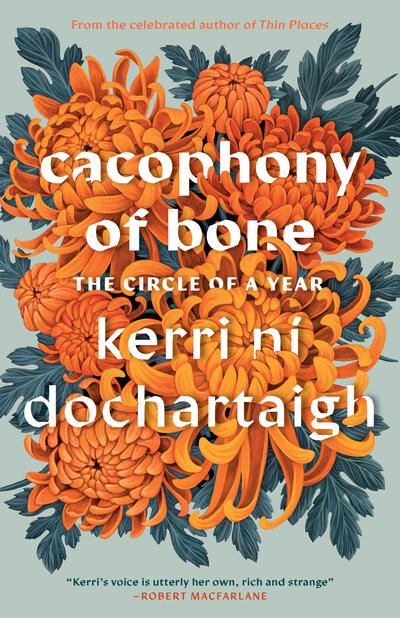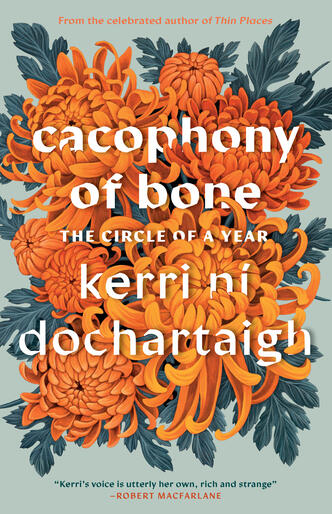Interview with Kerri ní Dochartaigh, author of Cacophony of Bone: The Circle of a Year

Milkweed Staff (MS): In your first book, Thin Places, you write about being born during the height of the Troubles in Ireland. In that book, you asked readers to reclaim our landscape through language and to remember that the land we fight over is much more than lines on a map. In Cacophony of Bone, you write about another time of great upheaval and trauma: the global pandemic of 2020. How do you connect these two books in your mind?
Kerri ní Dochartaigh (KnD): When I first spoke to my British editor after acquisition, he told me how excited he was to publish the book, as it was “the follow up to Thin Places”—a statement which shocked me. He noted “Cacophony of Bone literally begins where Thin Places ends”—and only then did I begin to see them as related to one another in a way. They are related in that each is a fragment of the whole; a glance into the looking glass of a life lived and all that that might mean. The themes of the wonder of the natural world, of looking and listening, of hope and healing—are there in both, and I feel that my becoming a mother has cracked me open irrevocably; taken my heart and laid it out on my kitchen table.
I hope that readers who loved Thin Places will find much to love here in the pages of Cacophony, too. But there is something in me that hopes that this book will reach a new set of readers, those that seek solace in words; those that perhaps are trying to make peace with a new stage of their life; that are grieving a loss; those that feel lost and are in need of a very particular kind of light. Where Thin Places was a telling of a glimmer of light on mothwing, Cacophony is a telling of light in such abundance as to be almost unbelievable at times. To have others read of and share that light, is a joy beyond any words.
MS: Whereas Thin Places is a memoir written in prose, Cacophony of Bone feels like a blend of intimate journal entries and poetry. This might strike readers as the truest way one could recount the waves of feelings, fears and strange new experiences that hit all of us on a daily basis during the lockdown. Did you come to realize that you needed to write this book in a very different form than the last? And what was it like to write so intimately about a period of time that so many people—if they’re being honest, since it was painful in so many ways—probably want to forget?
KnD: For quite some time in the earlier parts of the pandemic, I struggled to write creative nonfiction. Everything I wrote ended up as a surreal, oddly boned piece of fiction. I realized early into that time that the way I wrote would have to change in order to meet the changes of my lived experience, and those of my reader, too.
The times through which we lived, back then, are the kind many wish to forget—as is often the way with things that take us out of our comfort zone and leave us changed. But the thing is that many of those changes were good ones; many of the things that have remained from those years are for the better. Like with any experience in life, we lived and loved and grieved and grew, despite it all. The swallows came, built their nests, and left. The seasons came and went and there is so much in this life that is worthy of note, no matter how dark the sky.
I did the only thing I have ever really known how to do in times of dark, or of light, or of both: I wrote. I recorded those days as truly and as best I could. I wanted to remember what they held and what they did not hold; what they meant and what they did not mean—I wanted to remember my way back to the beginning. I did this through a work that is as fragmentary as it is lyrical, exactly like life is.
MS: Throughout the book and throughout your year of lockdown, you drew so much on literature. You cite the poetry of Alice Oswald, prose of Annie Dillard, Joseph Brodsky, Annie Ernaux, Terry Tempest Williams, Doireann Ní Ghríofa, and many others. Can you talk about the role reading played in your daily life through this time?
KnD: It is not a coincidence that during the times I saw fewer humans than ever in my life before then, I turned to the words and the worlds they had created as refuge in the storm, a way of connecting that went beyond the realm of the physical. I was hungry for story, for imagery—for life, I suppose—and I found it in the words of those who had lived through times both completely like, and utterly unlike, the times in which we all had found ourselves.
I have always been an insatiable reader but those lockdown years were unlike any that had come before in the shape my appetite took. As well as reading so much more than normal, I began to read things I never before would have dreamed. I also stepped away, finally, from the self-inflicted guilt that long had surrounded reading for me. If I wanted to read the same book three times in a row in one week, I simply did so. I began, for the first time properly, to write down lines I loved in books in my journal, instead of just folding down the pages. Instead of telling myself it didn’t matter, I started to keep a note of every single book I read, under the month in which I read it: a seasonal log of words.
MS: Can you talk about the experience of writing, of meeting deadlines, of revisiting words you’d written years prior while in lockdown?
KnD: I have never been more grateful for demands of deadlines than I was during those early lockdowns in particular. When all was unsure, nothing at all steady on which to lean, I had words to which I had to show up and I was so grateful. Reviews to sculpt, writing courses to mold, podcasts to record; these things held me in close and helped to buoy me when all felt more tumultuous than I can even begin to describe. I edited Thin Places at the end of a muddy laneway, with no internet at all, locked down to within two kilometers of a small, single-roomed stone cottage. It was the most traumatic work I had ever done but somehow it was also the more beautiful—odd though that may sound—that the circumstances were those. When I finished the final edit, my partner cut all my hair off in our first garden, and we watched as bluetits gathered it up and carried it off in their beaks. Within moments they had started to build their nest with it, and that felt too moving to even try to comment on. I simply recorded it in my journal, which felt like a delicate act of deep rebellion, somehow.

